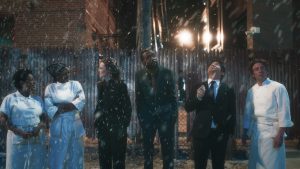
The most important person in the Mad Max movies is not, in fact, Max Rockatansky. Nor is it Imperator Furiosa. It isn’t even one of the villains, be they Immortan Joe or Lord Humungus. No, the most important person is the tattooed old man seen in Furiosa: A Mad Max Saga.
Played by George Shevtsov, he is known simply to his flock and overlords as the History Man, one of many elderly people in the Mad Max universe tasked with keeping records of times past. When someone like Dementus (Chris Hemsworth) calls for a “wordburger,” it’s the job of the History Man to provide explanation and context. Likewise in Mad Max: Fury Road, a History Man, or in this case History Woman named Miss Giddy (Jennifer Hagan), teaches the wives of Immortan Joe who killed the world… hint: it was not other women.
As you can probably guess, the History Men’s methods of record-keeping are flawed, given to misremembering and misrepresentation. That’s important to keep in mind, too, when thinking about anything that happens in the Mad Max movies, such as the ending of Furiosa. This emphasis on misremembering and mythology in the Mad Max franchise underscores a central truth of aesthetic interpretation. Making sense of any type of art, post-apocalyptic road movie or otherwise, needs room for plenty of personal explanations. No single explanation covers all possibilities.
The Many Deaths of Dementus
“This is the truth, whispered to me by Furiosa herself,” says the History Man at the end of Furiosa. He goes on to explain the final fate of Furiosa’s (Anya Taylor-Joy) kidnapper, Dr. Dementus. According to the History Man, Furiosa took Dementus into the Citadel, the elevated home base of Immortan Joe (played by Lachy Hulme in Furiosa, who took over for the late Hugh Keays-Byrne from Mad Max: Fury Road).
There Furiosa buries the still-living Dementus into the soil at the top of a remote cliffside and plants within him a seed from her home in the Green Place. Dementus becomes human fertilizer for a peach tree, ending his life by creating instead of killing.
It’s a powerful and poetic ending, one that contains “beauty” and “salvation too,” wrote Den of Geek’s David Crow. “That tree is a promise of a better, hopeful future that breaks the cycle of violence, suffering, and revenge that made Furiosa. The legacy of her idealized Green Place lives on in the Citadel she refuses to call home.”
Pleasing as it is, the tree ending is just one of several possibilities, all of which the History Man offers. In the most simple version, Furiosa just shoots Dementus in the head, killing him in the desert. In another, she drags him along behind her vehicle, forcing him to walk the same fatal path he inflicted on others, including Furiosa’s friend and possible lover, Praetorian Jack (Tom Burke). Likewise another version finds Furiosa hanging Dementus on the same cross he used to torture her mother Mary Jabassa (Charlee Fraser).
While the History Man notes that the peach tree punishment is the “true” ending, he also acknowledges that it’s one that he heard from Furiosa and didn’t see himself realized. That distinction emphasizes the subjective element, as one’s personal experiences and desires affect the telling. Indeed, the History Man notes that other people prefer the retributive deaths that Furiosa meted out with her car and the cross. Who’s to say that Furiosa or the History Man don’t think the tree ending is true because it’s just the one they like best?
The History Man shows his own subjective nature earlier in the film too. When he first meets Furiosa (then portrayed by Alyla Browne), the elder urges her to become a History Man herself, so that she can be “useful” to Dementus and be rewarded. He shows off that usefulness by providing definitions of words of Dementus and when he introduces him to enemies, announcing the “might” of the warlord.
The History Man functions as the prime interpreter in Furiosa, showing that the meaning of the film cannot be separated from one’s own subjective opinions and desires.
History Men of History
Furiosa director George Miller didn’t publicly use the term History Man until 2015 in the supplemental material for Mad Max: Fury Road. The prequel comics published by DC Comics’ Vertigo imprint followed Miller’s extensive notes and backstories for Fury Road, and those stories were brought to life by writers Nico Lathouris and Mark Sexton (both of whom worked on the film), and artists Riccardo Burchielli, Leandro Fernandez, Andrea Mutti, and Sexton. It’s revealed these comics are by a History Man too.
Of course Miller and his original co-writer Byron Kennedy didn’t use voiceover or History Men the first film in the franchise, 1979’s Mad Max. But the idea of mythology does play a role in 1981’s Mad Max 2 (also known as The Road Warrior in the U.S.). That film begins and ends with an unnamed narrator describing how policeman Max (Mel Gibson in the first three films) went mad in the final days before the Fall. Presumably this is to suggest how we went from the disillusioned copper of the first movie to the literal Road Warrior riding along a desolate hellscape in the sequel.
That demarcation between the first movie’s pre-apocalyptic setting and the development of the Wasteland for all of the other films underscores the importance of the History Men. After all, we had books before the world died and didn’t need to rely on tattooed storytellers. The History Men carry the knowledge otherwise easily forgotten in the desolation.
Thus the narrator at the start of The Road Warrior is likely a History Man, telling the audience about the adventures of Mad Max, a noble warrior he claims to have met in his youth. And because the History Man might make mistakes like anyone else while recounting memories from decades earlier, “the truth” of this film’s epic tale is invited to be questioned. This further applies to the events of all remaining Mad Max movies. From The Road Warrior on through Furiosa, the events of these movies aren’t necessarily “true” within the world of the films.
Instead they are legends and myths, stories that History Men tell the survivors to try to retain humanity’s dignity and honor while surviving in a dying world.
In other words, each of the Mad Max movies are interpretive works, not regular narratives. They don’t hold to some objective truth as much as they do to the proclivities and assumptions held by the storyteller, who put their own experiences ahead of some type of reality. It can even explain contradictions between the films, be it the state of human civilization’s decline between Mad Max and The Road Warrior, or even why Max himself looks so radically different between Mad Max Beyond Thunderdome and Fury Road.
History, Today
Furiosa ends with a montage of scenes from Fury Road. At first glance, this montage seems like an obvious connector between the two movies. But because they come along with the History Man’s admittedly unreliable narration, the scenes throw Fury Road into confusion.
That sounds bad, but Mad Max is always about confusion. The franchise occurs in a world thrown into disarray. But it’s not a world of despair. It’s a world in which hope is found through stories to help give sense to the world, whether it’s a sense of justice when a woman kills her tormentor in the desert or a sense of hope when she transforms him into nourishment for others.
Through these stories, we the audience see how we also interpret narratives according to our needs, worrying less about one, unimpeachable truth or “canon,” and more about the tales we tell to survive and make sense of our own history and present.
The post Furiosa: The History Man Is the Most Important Character in the Mad Max Mythos appeared first on Den of Geek.










